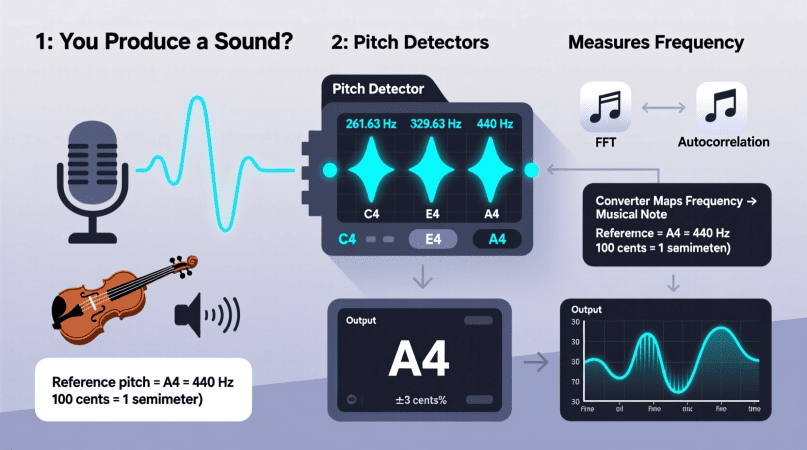
Yes. A pitch detector listens to a sound, measures its frequency, and then matches that frequency to the closest musical note.
But the real value lies in understanding how this works, where it fails, and how you can use it to your advantage as a musician, singer, or audio engineer.
How Pitch Detection Actually Works
Think of pitch detection as a translator between the physics of sound and the language of music.
- Capture the sound
A microphone records your voice or instrument. - Analyze the frequency
Algorithms such as autocorrelation, FFT (Fast Fourier Transform), or YIN search for the fundamental frequency — the “root” vibration beneath all the overtones. - Map to a musical note
The software compares that frequency to a tuning standard (usually A4 = 440 Hz) and outputs the nearest note. Frequency (Hz) Musical Note 261.63 C4 (Middle C) 293.66 D4 440.00 A4
This process happens in real time, which is why apps and tuners can instantly display what note you’re playing.
Try Our: song pitch detector
Pitch Detector vs. Tuner: What’s the Difference?
It’s easy to confuse pitch detectors with tuners.
- Pitch detector: Designed to recognize any note from sound and tell you what it is. Useful for singers, transcription, or analyzing recordings.
- Tuner: Built for adjusting an instrument to the correct pitch. It doesn’t just identify a note — it shows how sharp or flat you are compared to standard tuning.
Both rely on the same core technology but serve different purposes.
Try: online pitch detector tool
Where Pitch Detectors Struggle
Pitch detection isn’t flawless. Here are common limitations:
- Monophony only: Most apps can only detect one note at a time. Play a chord on a guitar, and the detector will likely guess or get confused.
- Vibrato and bends: A singing voice with vibrato or a guitarist bending notes produces frequency fluctuations that may confuse the software.
- Background noise: Noisy environments make it harder for detectors to lock on to the correct pitch.
- Harmonics and timbre: Instruments rich in overtones, like violins or saxophones, can “trick” simple algorithms.
Real-World Uses
- Singers: Track pitch accuracy and train your ear with apps like Singing Carrots or Find the Note.
- Musicians: Use detectors to identify riffs or melodies by ear and convert them into notation or MIDI.
- Producers: Run pitch analysis on vocal takes to see where a singer drifts before applying pitch correction.
Some tools even support automatic music transcription, turning a melody into written notes or MIDI files for editing in a DAW.
Advanced Applications
Behind the scenes, engineers and researchers push pitch detection further:
- Polyphonic detection: Separating multiple notes in a chord (still challenging but improving).
- Machine learning models: Training AI to recognize pitch more like a human ear.
- Real-time processing: Low-latency algorithms for live performance tools and vocal processors.
Common Questions About Pitch Detectors
Can a pitch detector detect multiple notes at once?
Most consumer-grade detectors cannot. Polyphonic detection exists but requires advanced software.
Are pitch detectors accurate for singing?
Yes, especially for steady tones. Vibrato or sliding notes may cause the output to “wobble.”
How is a pitch detector different from a tuner?
A pitch detector tells you what note is being played. A tuner tells you whether it’s in tune.
Do smartphones detect pitch reliably?
Modern smartphones are surprisingly accurate for single-note detection thanks to powerful processors and sensitive mics.
Pitch Detector is a project by Ornella, blending audio engineering and web technology to deliver precise, real-time pitch detection through your browser. Designed for musicians, producers, and learners who want fast, accurate tuning without installing any software.
